Unprocessed FAQ: Meat & Eggs
Oct 14, 2019
This post isn’t about whether or not one “should” or “should not” eat meat or eggs in general, as I’m deliberately avoiding that question. I also include a section about “vegetarian meats,” so to my vegetarian and vegan friends: Read on!
And… so many amazing people have now joined the October Unprocessed challenge! Why don’t you join us?
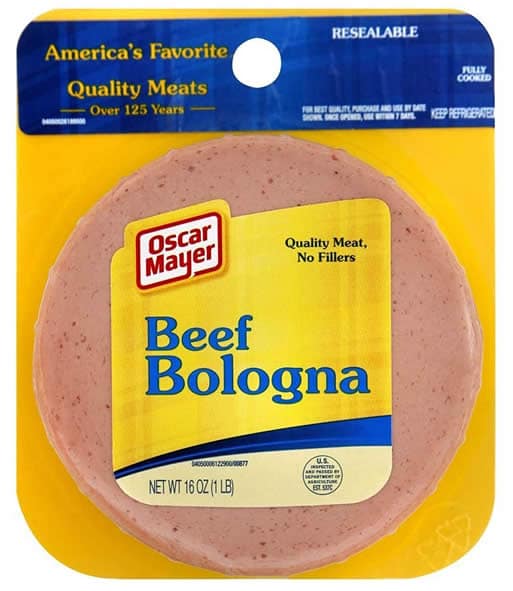
Our supermarkets, with their sterile, plastic-wrapped packages of pre-butchered meat, do an effective job of shielding us from the reality of where our food comes from. That means that the meat you’re eating may not be as unprocessed as you think it is. Hopefully, this post will help you walk into the grocery store with eyes wide open so you can better decide what’s right for you.
Cold Cuts, Deli Meats, and Cured Meats
Cold cuts and deli meats are going to vary widely, of course. The hard part in today’s world is that there are often a lot of shortcuts and other ingredients used to help speed their process, keep the product stable longer, or provide consistency and uniformity so that it’s the same every time you buy it, no matter where or when you buy it.
Let’s start with the ingredient list in Oscar Mayer’s Beef Bologna cold cuts:
Beef, Water, Corn Syrup, Contains Less Than 2% of Salt, Ground Mustard Seed, Potassium Lactate, Dextrose, Hydrolyzed Beef Stock, Sodium Lactate, Autolyzed Yeast, Sodium Phosphates, Sodium Diacetate, Sodium Ascorbate, Sodium Nitrite, Flavor, Extractives of Paprika, Oleoresin Celery Seed.
(Did you notice the mysterious “Flavor” in the list? That’s probably MSG. Same goes for Hydrolyzed Beef Stock and Autolyzed Yeast – both are very high in glutamates, so they add those to “improve” the taste.)
Okay, so that was too obvious an example. So how about Applegate’s Roasted Chicken Breast deli slices?
Chicken Breast, Water. Contains Less Than 2% Of The Following: Honey, Salt, Potato Starch, Carrageenan (From Seaweed).
Definitely much better, but they’re still adding ingredients you really wouldn’t use at home if you were going to roast some chicken breast and slice it for your sandwich. (I’m guessing what they’re actually doing here is pureeing the chicken into a paste, adding the sugar, salt, and thickeners, and then shaping it into a loaf, then cooking and slicing it. If anyone knows for sure please chime in in the comments section below.)
The bottom line for cold cuts and deli meats? You’ll need to read the ingredients carefully and make sure each passes the kitchen test.
So how about cured meats — such as bacon or salami? People have been curing meats at home for thousands of years. You still can, for example, make pancetta, beef jerky, and other charcuterie at home. The challenge is that today’s store-bought cured meats may or may not pass the kitchen test — and most probably won’t. Just like the deli meats, you’re going to have read the ingredient list and decide if that particular option passes the test.
Individual “Cuts” of Meat
Chicken, for example, is often injected with salt water and other additives to keep it “plump.” (Oh, and then they also get to charge you $4.99/pound for salt water.) For example, the Tyson “All Natural Fresh Boneless Skinless Chicken Breasts” shown above actually have up to 15% — fifteen percent! — chicken broth, sea salt, and “natural” flavorings (which likely aren’t actually natural).
Or consider ground beef. A pound of ground beef (that wasn’t ground by your local butcher), could actually contain meat from more than a hundred cows. That may not make much difference nutritionally, but it speaks to the degree of large-scale processing with which produce our food and the lack of transparency thereof.
(Ground beef may also be “washed” with ammonia to kill E. coli and Salmonella…Though after the “pink slime” outrage a few years ago, some companies have been moving away from that practice.)
Eggs are yet another story. Whole eggs, still in the shell, aren’t being “faked” just yet, thankfully. Of course, if you’re using pre-cracked eggs (such as a carton of “Egg Beaters”), odds are it won’t pass the kitchen test. You’ll definitely need to read the full ingredient list for those (I can almost guarantee they’re going to have thickeners, stabilizers, and “natural” flavor).
From the ingredient-based perspective of the kitchen test, the best bet is to read the label (if there is one) very carefully, buy meat directly from a farmer or butcher, and do your homework as best you can on that particular brand and product.
Vegetarian and Vegan Meat Alternatives
There are many meat alternatives available now — far more than ever. Unfortunately, many of them are just as ultra-processed as what they’re trying to replace. From an ethical standpoint, I totally get it – you’re not killing animals for your food (that’s exactly what started me on this food journey, many years ago!). But from an unprocessed perspective (and what this challenge is all about), many of those aren’t great choices.
The most common ingredient in modern meat substitutes is textured vegetable protein, or textured soy protein. The manufacturing process of TVP is fascinating (a testament to human ingenuity!), but something you definitely couldn’t be doing at home. Pea protein (or more accurately, pea protein isolate) has become popular in the past couple of years as well, but you’re also not going to be making that at home.
So how about the more “traditional” meat alternatives?
Tofu usually passes the kitchen test, as you can make tofu at home (but double-check the ingredients, of course). Tempeh, made from cooked and fermented soy beans, is also truly traditional, and the ingredient list on store-bought tempeh tends to be clean (but again, double-check — especially the “flavored” varieties). Seitan is a gray area… You can make seitan at home from wheat flour, but at the commercial level it’s usually made with vital wheat gluten (which you can’t make at home), so I’ll leave that one up to you to decide.
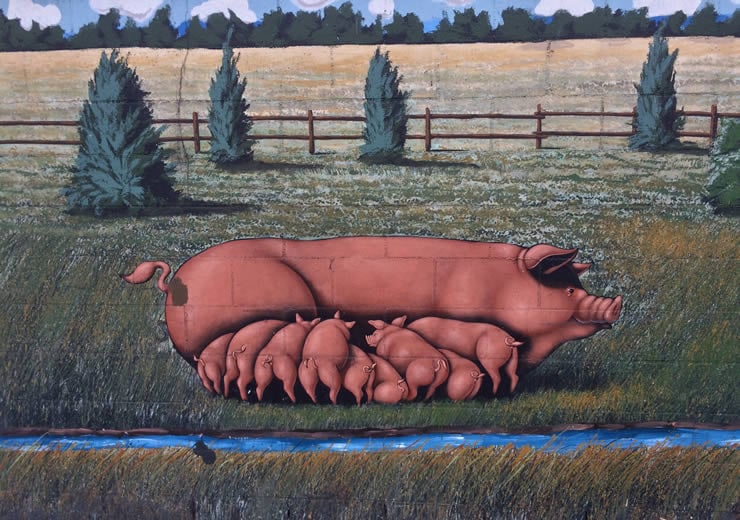
The Best Way to Unprocessed Meat
Ultimately, I’ve found that beyond the “obvious” processing (such as when there actually is an ingredient list on the package), the best way to get “unprocessed meat” is to focus on the treatment of the animals while they’re still alive.
How the animals are treated, how much space they have, if they’re indoors our out, if they can move freely, what they are fed, how they’re slaughtered, and what happens before it gets to you all makes a world of difference, both in the animals’ health (and therefore of the meat or eggs you’re eating), but also in the health of the planet.. and in your overall good Karma, too, of course.
Take another look at my photo of the Farmer John mural above. When I drove past it, I was so appalled at the blatant lie that I actually got out of the car and took several photos. In reality, 9 out of 10 sows in America are locked in gestation crates where they are basically immobilized — for years.
Here’s the actual, brutal reality:
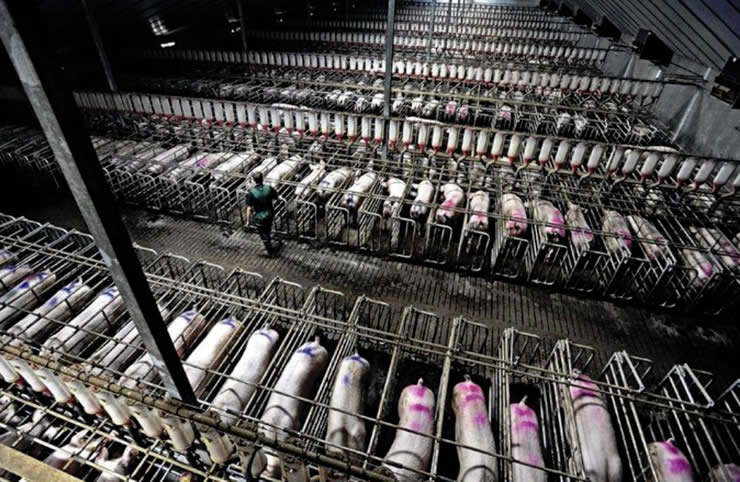
Chicken isn’t usually much better, although at least chickens raised for meat aren’t usually confined to minuscule cages like their egg-laying counterparts so often are. Even so, the majority of the 9 billion chickens raised for meat in the US. each year live in crowded, dark, deplorable conditions on factory farms. Selectively bred for rapid weight gain, today’s chickens are so over burdened by their bodies that they spend much of their short lives lying in their own waste.
These conditions aren’t only bad for the chickens — they can also have negative implications for food safety. Chickens raised on factory farms often have open wounds, which can act as a gateway for bacteria like Salmonella. Farms routinely administer low doses of antibiotics to their chickens through their feed, in order to keep them alive and growing in such unhealthy conditions, which poses a risk to our health by creating new, antibiotic-resistant bacteria.
It Gets Better (but watch your step)
Thankfully, there are more humane options now, and it’s possible to choose higher-welfare certified products. More and more people have been paying attention, and “voting with our dollars” actually does work. Now, it’s possible to find sustainably, humanely raised meats in farmers markets, local farms, and many grocery stores across the country. But it can still be very confusing, since there are so many labeling pitfalls and misdirections. Some words used on labels have legal definitions, but others are just misleading marketing claims that aren’t actual third-party certifications. It’s important to know what they really mean. Here are some of the most common:
“Cage-Free”
While cages themselves are prohibited, hens can be raised in enclosed, windowless sheds. Chickens and turkeys raised for meat (not eggs) are not usually caged anyway. For example, these chickens are considered “cage free”:
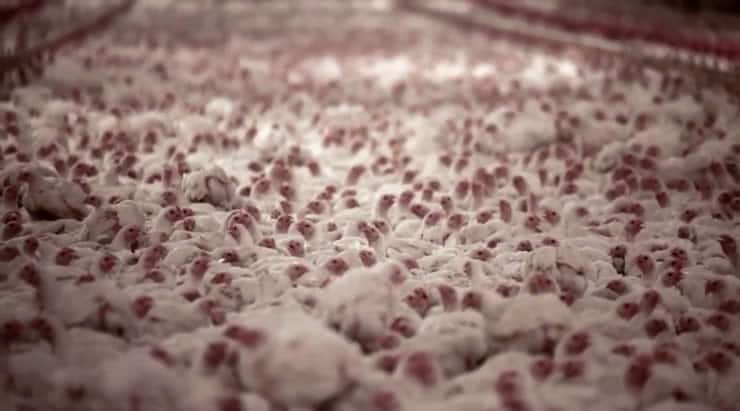
“Free Range” or “Free Roaming”
For chicken and turkeys raised for meat, this means the birds have “access to the outside.” But the size, duration, and quality of space are not defined and vary considerably. It could be a small dirt patch on one side of a very large barn (and when I say very large, I’m talking about 30,000 chickens under one roof), that a chicken on the other side of the barn may never even knows exists.
“Grass-Fed”
Unless it says 100% Grass-Fed, it means that the animals had access to pasture during the majority of their growth. Pretty much all cows are on pasture for the first portion of their lives, and are then moved to feedlots for “finishing,” so just calling beef “Grass-Fed” is essentially meaningless. Even 100% Grass-Fed could mean the cows are getting grass while in a feedlot.
“Natural” (including “All-Natural” and “100% Natural”)
This has absolutely nothing to do with how the animal was raised, only how the meat was handled after. It must contain no artificial ingredient (but “natural flavor” is okay since the USDA considers it natural. You already know I disagree on that one!), and it cannot have added color, and must be “minimally processed.” What’s minimally processed, you ask? It means the “product” was “processed in a manner that does not fundamentally alter the product.”
“Humanely Raised,” “Humanely Handled,” “Naturally Raised,” and “Vegetarian-Fed”
All of these are unregulated, and do not necessarily impact farm animal welfare. Any company can make this claim, with nothing to back it up.
“Certified”
This implies that the USDA’s Food Safety and Inspection Service has officially evaluated a meat product for class, grade, or other product quality characteristics. This would be something like “Certified Angus Beef.” It has nothing to do with animal welfare, what the animal ate, and so on. This should not be confused with third-party welfare certifications.
Actually Legitimate Third-Party Certifications
If I’m not buying direct from the farmer (such as Harvest Gathering Farms here in Los Angeles — tell Wendy I sent you), here are the certifications I’ll look for. The first three are the best, but any of these are better than nothing.
 Animal Welfare Approved
Animal Welfare Approved

 Certified Humane Raised & Handled
Certified Humane Raised & Handled

 Global Animal Partnership “Step 2” and above
Global Animal Partnership “Step 2” and above

- Step 1: Cages and crates prohibited. Animals can be kept fully indoors or on feedlots with a minimum space allowance.
- Step 2: Indoor environmental enrichment required.
- Step 3: Outdoor access required but not pasture.
- Step 4: Access to pasture required.
- Step 5: Feedlots prohibited.
- Step 5+: Animals must spend entire lives on one farm. Off-site transport prohibited. Hormones and subtherapeutic antibiotics prohibited at all steps. Standards extend to transport but
not breeding animals or slaughter.
The ASPCA recommends Steps 2 and above, which represent a significant improvement over conventional standards. My preference is at least Step 3, and definitely Step 4 whenever possible (it’s rare to see Step 5 or 5+ but when I do, I vote with my dollars). globalanimalpartnership.org
American Grassfed
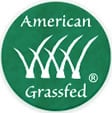
American Humane Certified
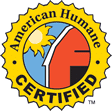
Organic
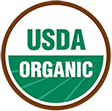
Do What’s Right For You
My hope is that this post has encouraged you to start thinking about meat in a slightly different way than before. We live in a culture that makes this very difficult, but every step you take towards less-processed meat (however you define it — whether that’s “Step 5” meat, veggie hot dogs, or no meat/meat-alternatives at all), I hope you’ll be a little more empowered to make some deliberate choices in the coming weeks to do what’s right for you.
Take this info with you!
Download the ASPCA’s printable Farm Animal Welfare Guide
If you haven't taken the October Unprocessed pledge yet, please do! And then encourage your friends to join in -- it's a lot more fun that way!
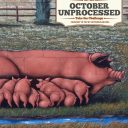

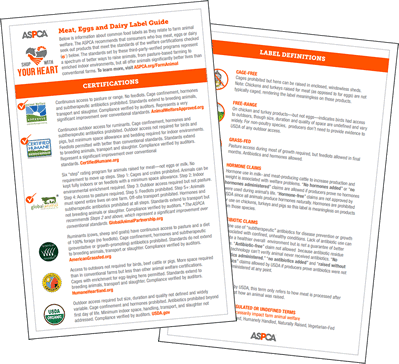
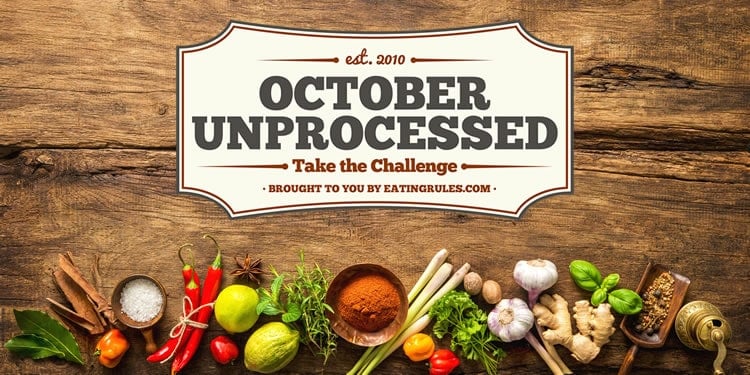


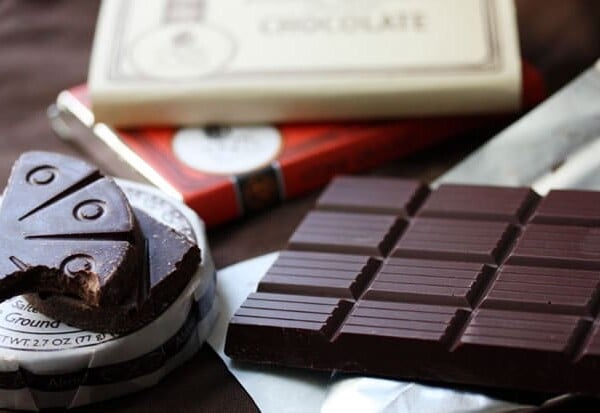

















thanks for sharing this nice recipe and I love this Andrew!!! So informative, and articulately put without judgement. of these reasons is why my husband and that i went pescatarian this year, leaning more towards vegetarian. We’ve tried the vegetarian meat alternatives, and that i just don’t like them. Can’t await October Unprocessed!
I like this article, it’s very informative. However, I am still left with the question. . . What do I eat?! What ARE the approved meat and meat-substitute brands/products I should eat? You are very detailed with what you should not eat (some of which I thought were okay to eat!) but where can I get a list of brands and products I CAN eat?
Very informative. Another great site for information is: weightandwellness.com
They also have a great podcast: dishing up nutrition